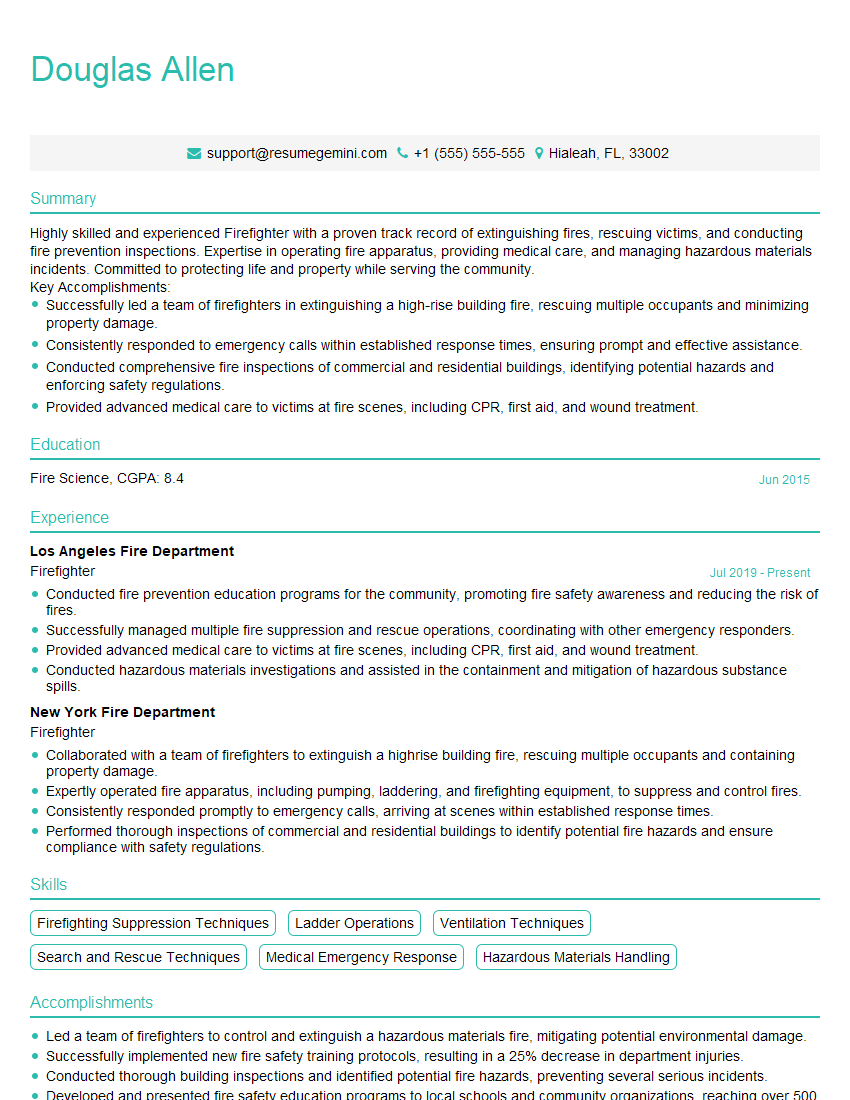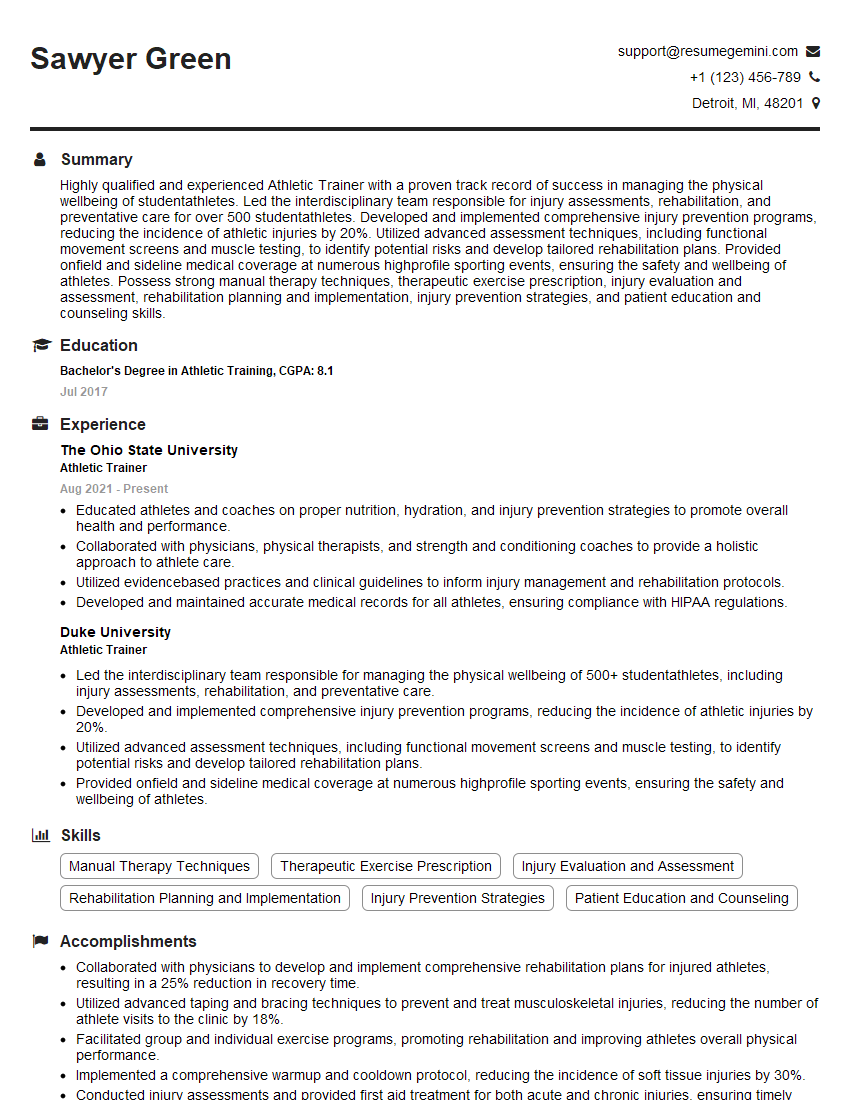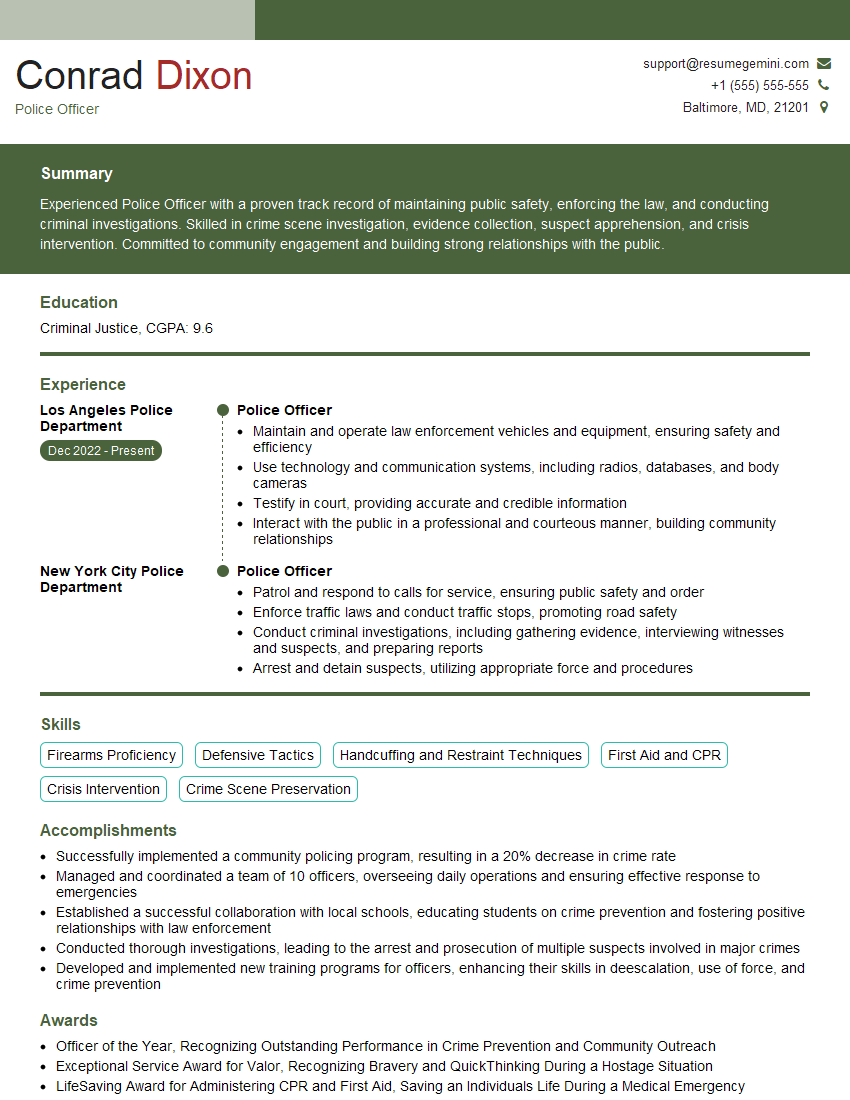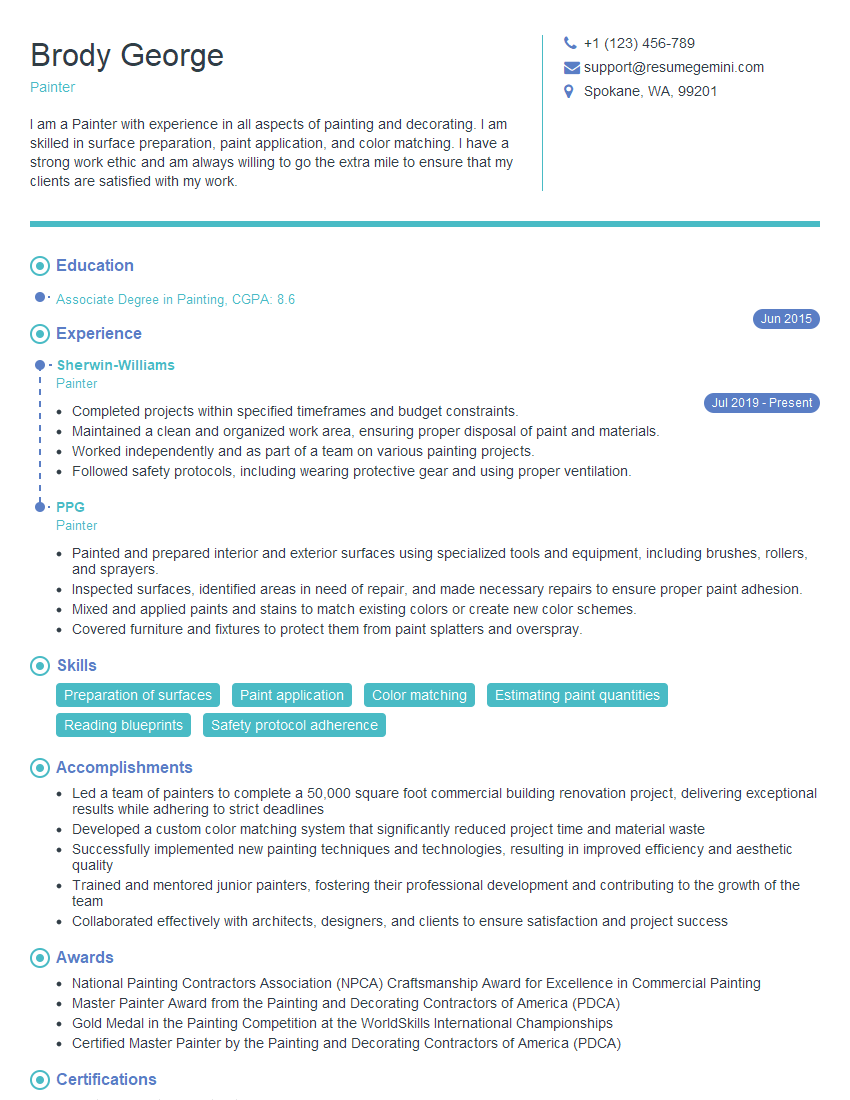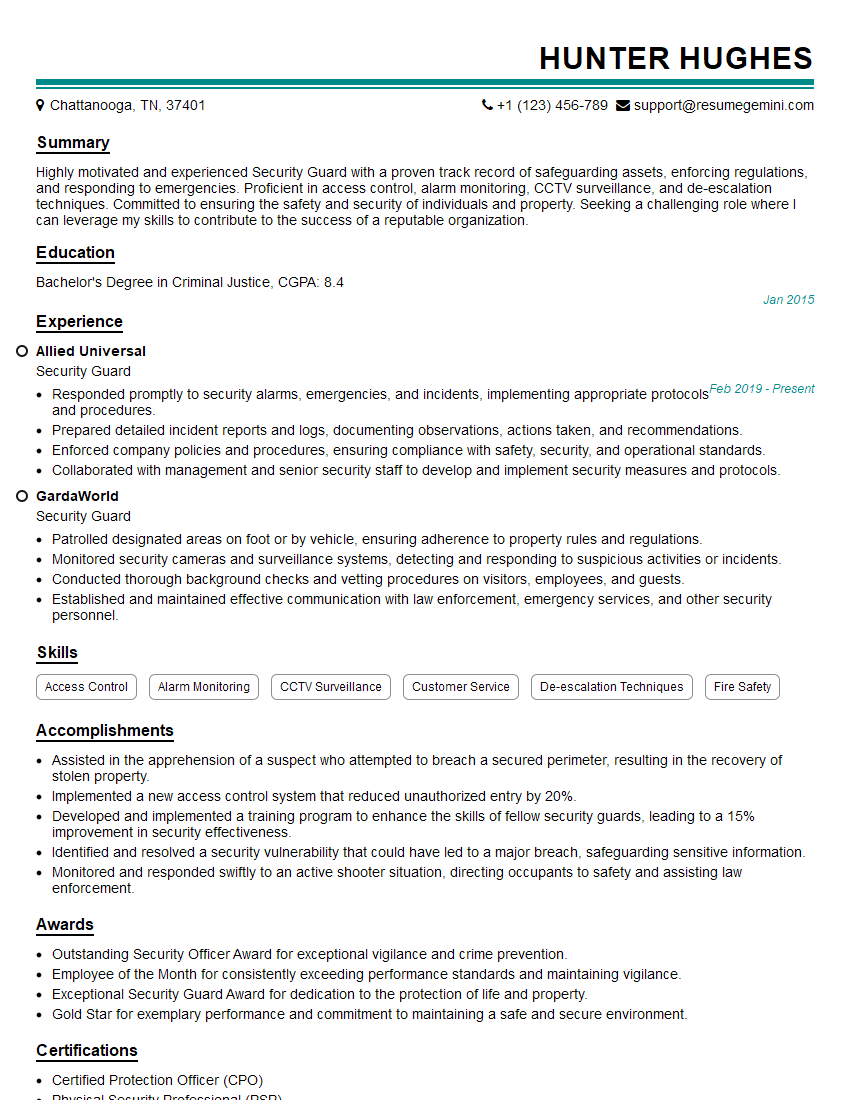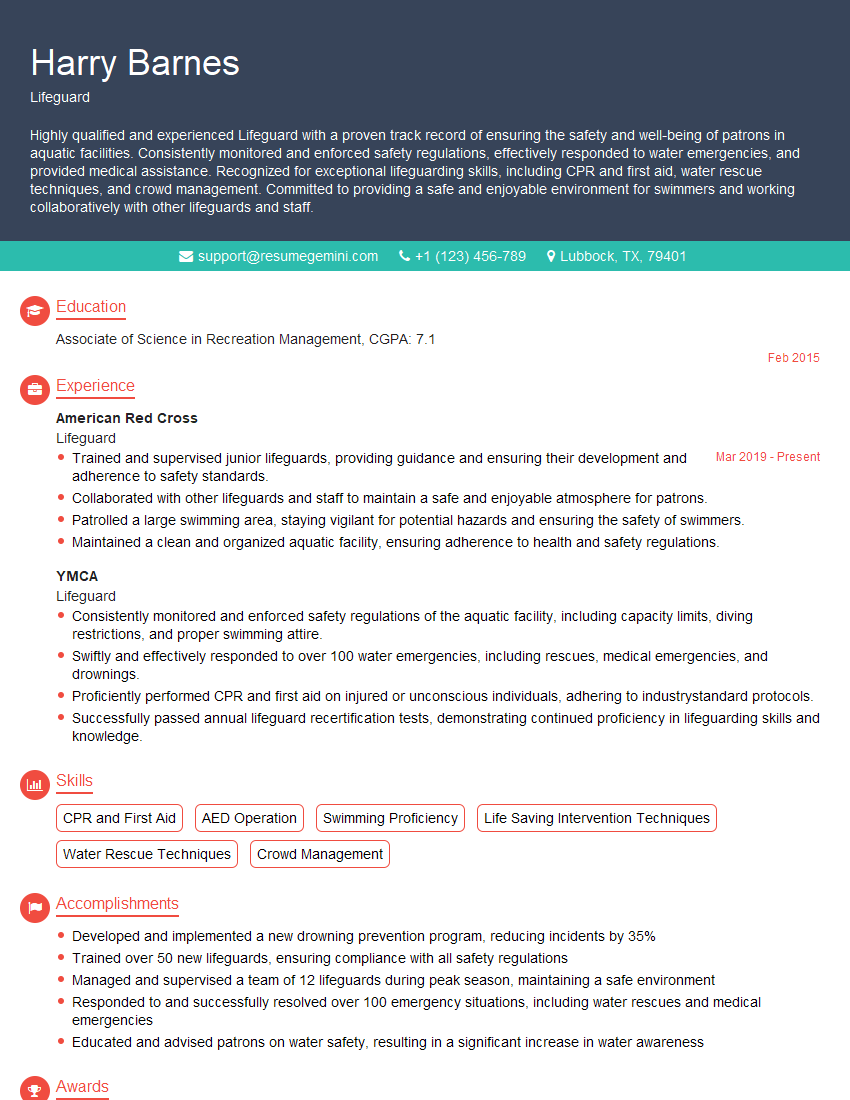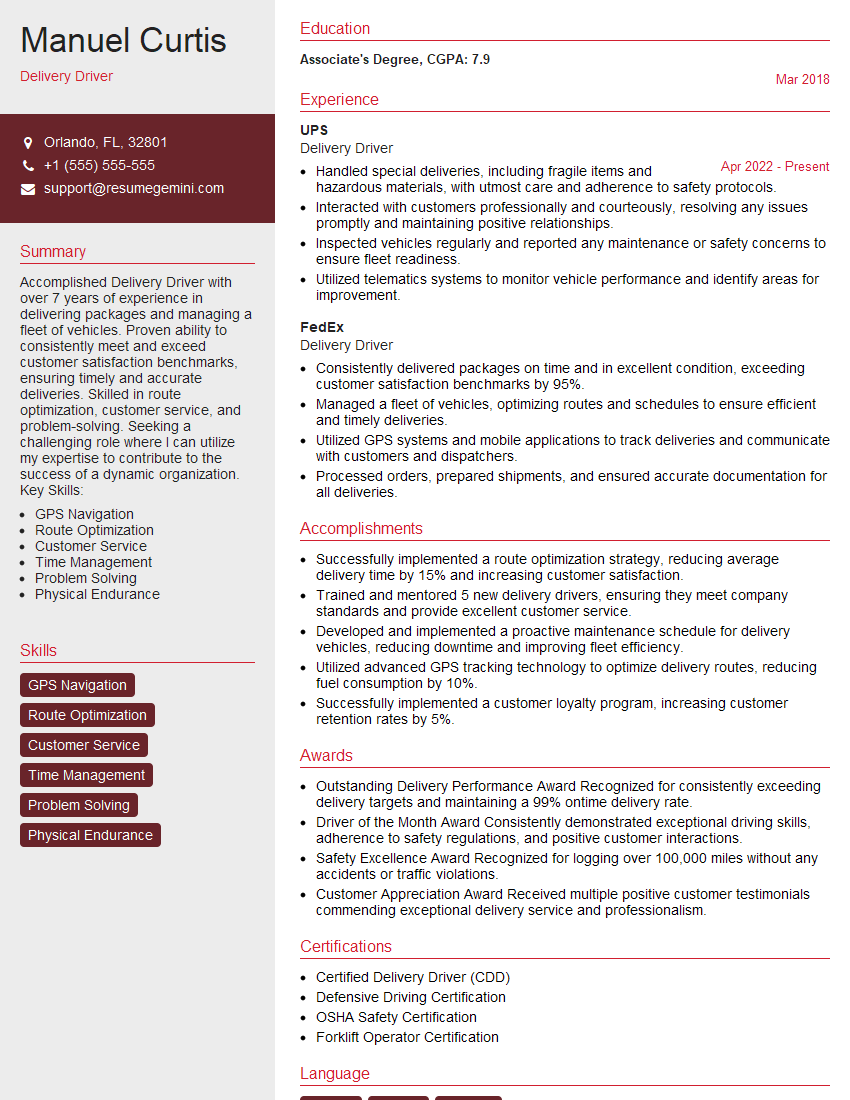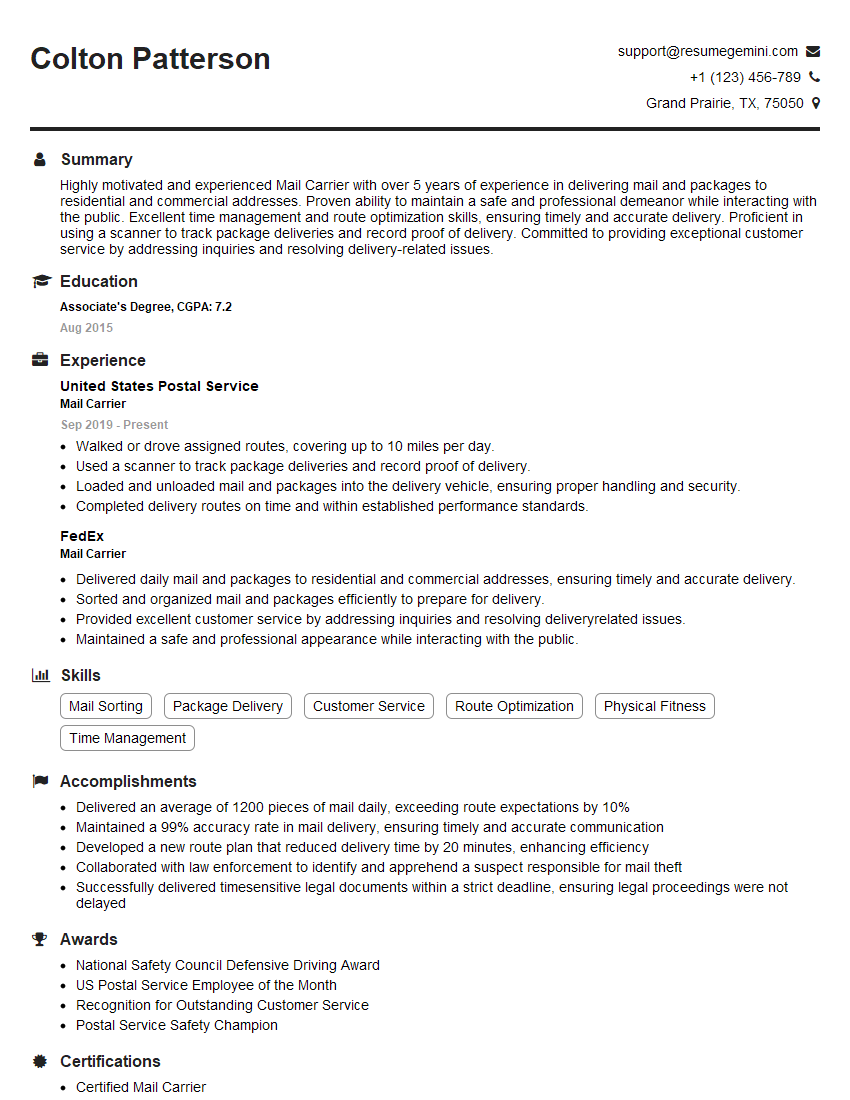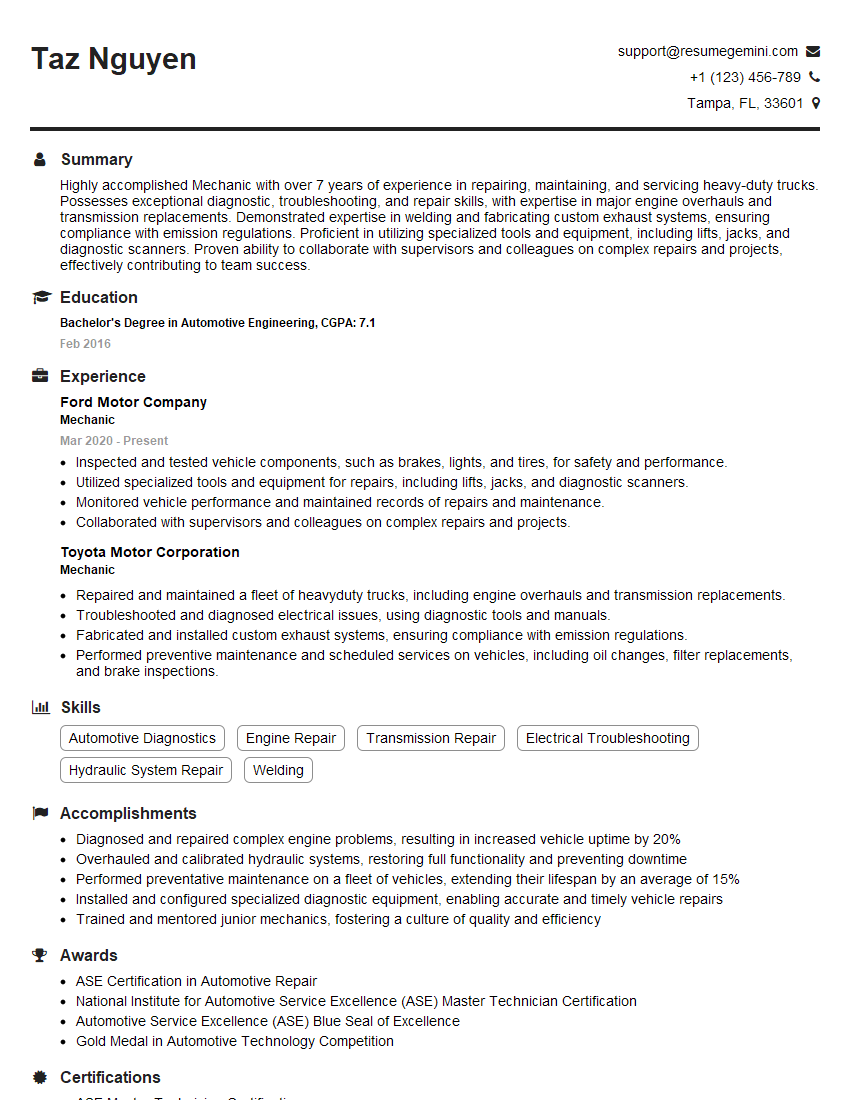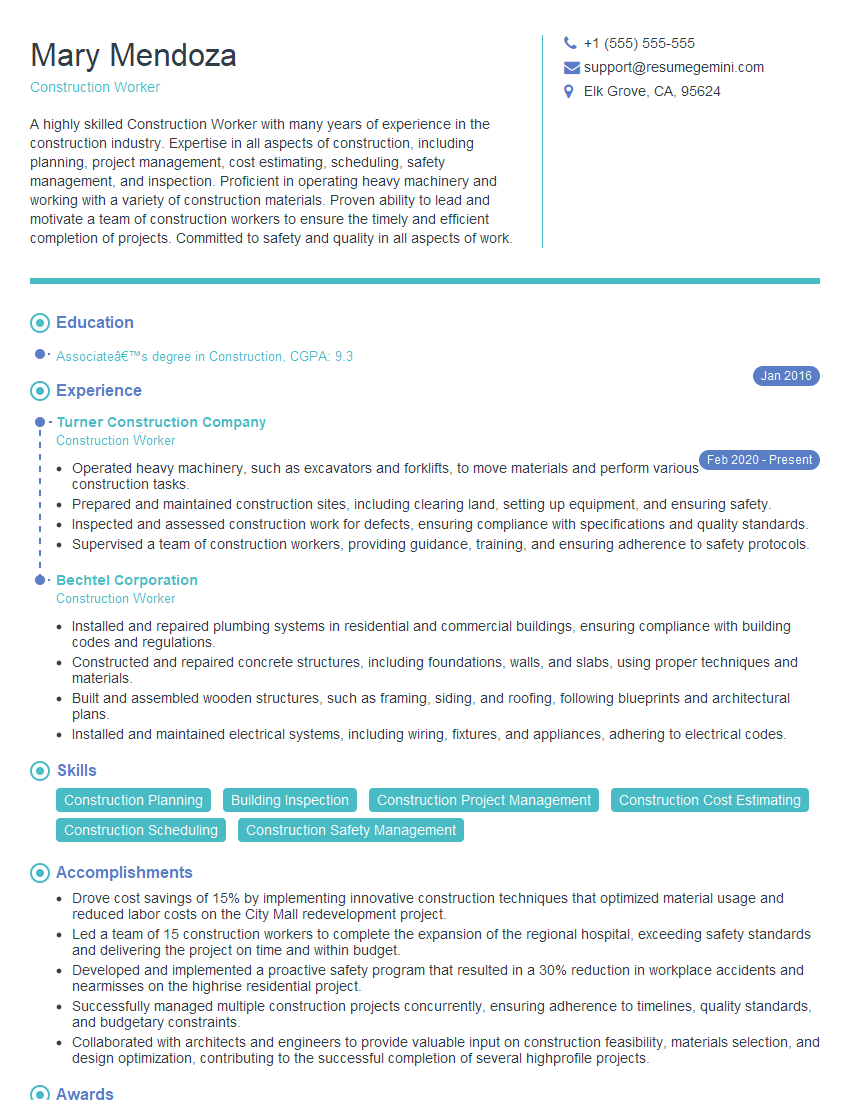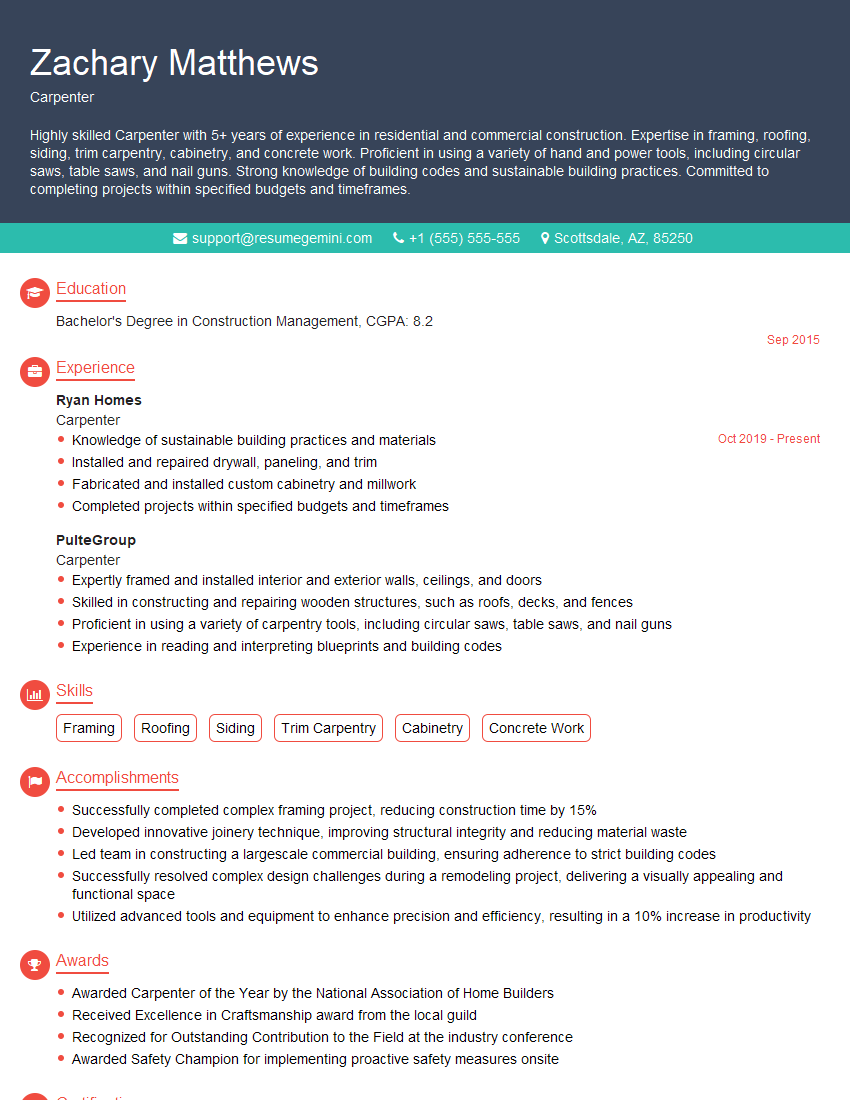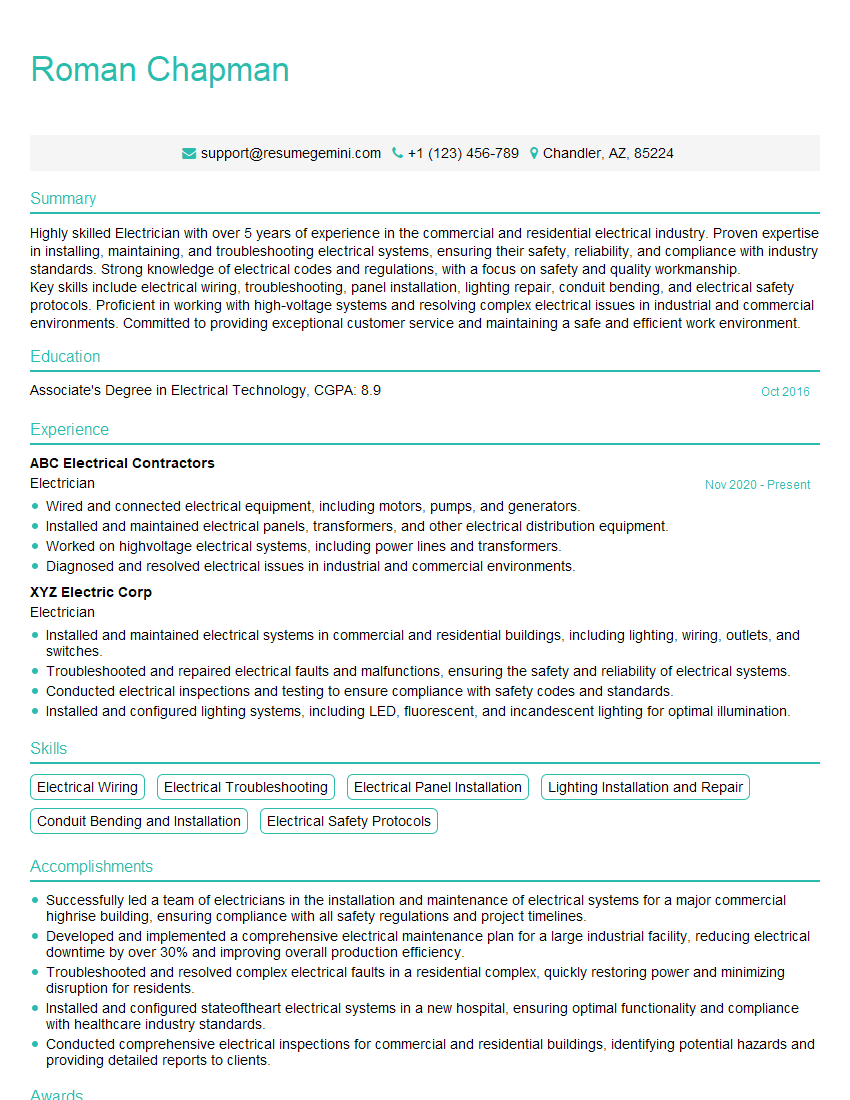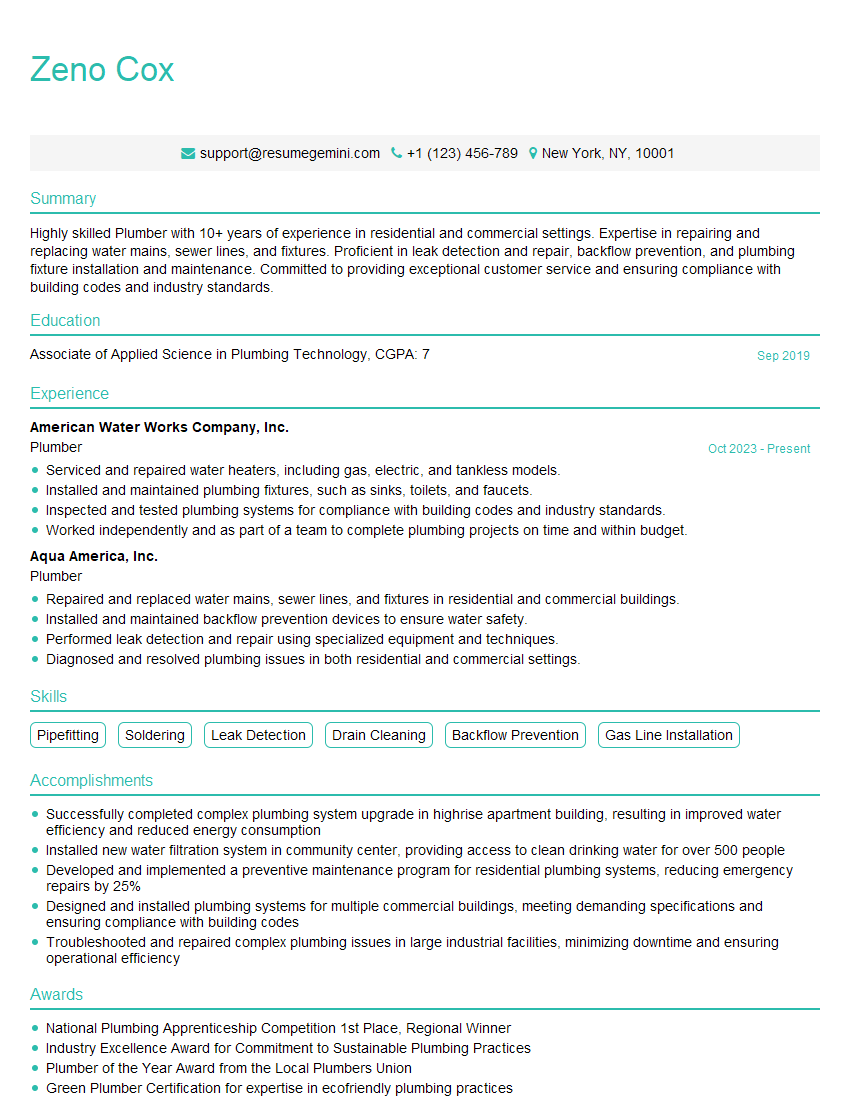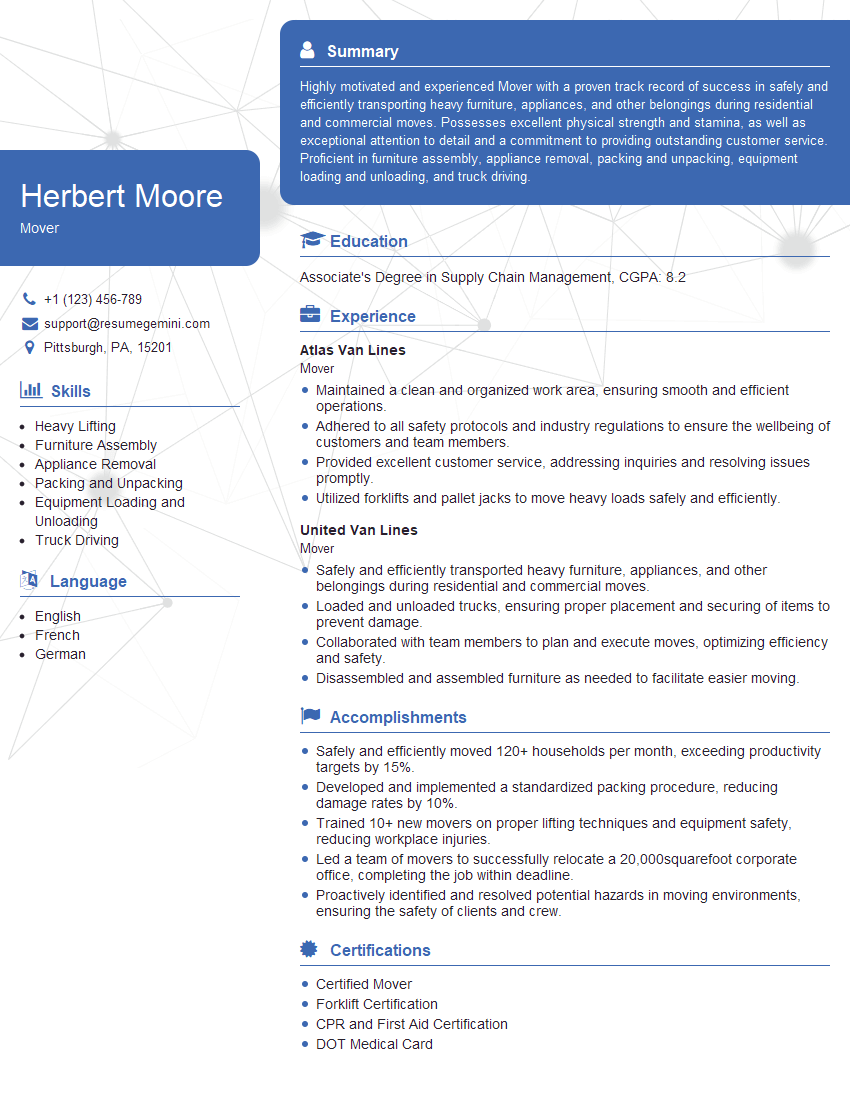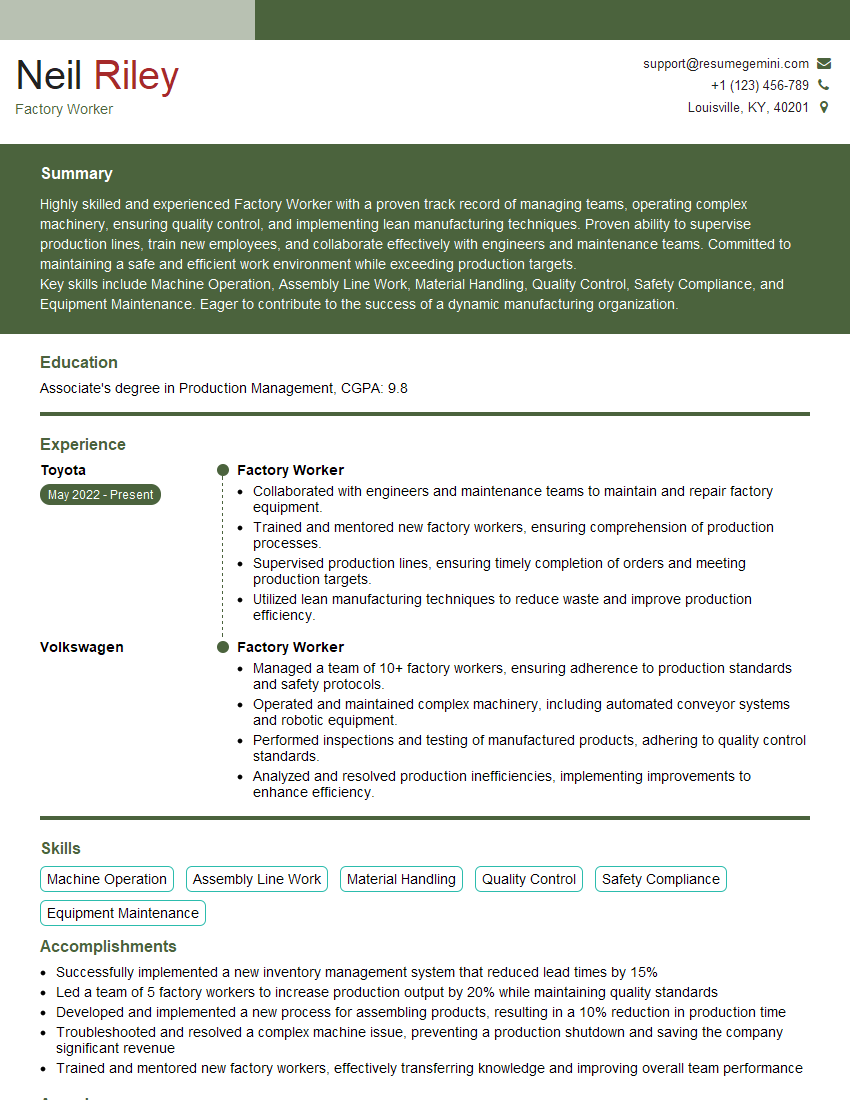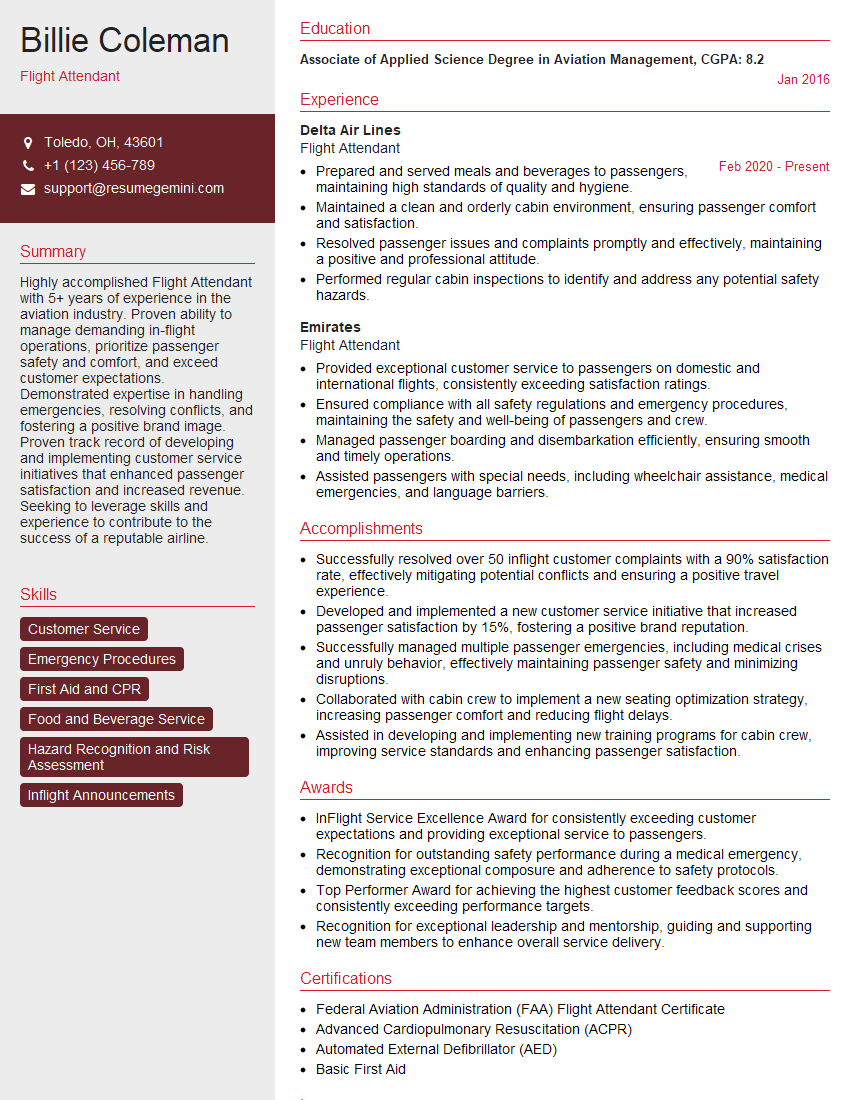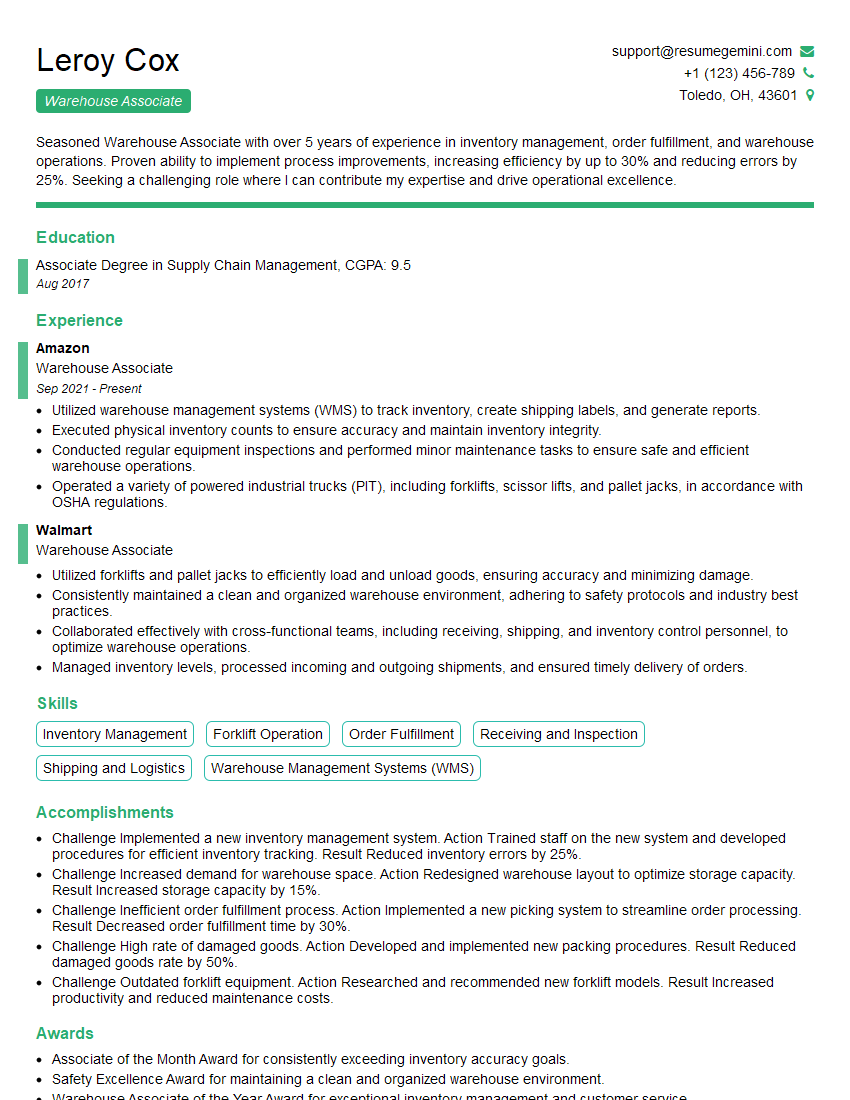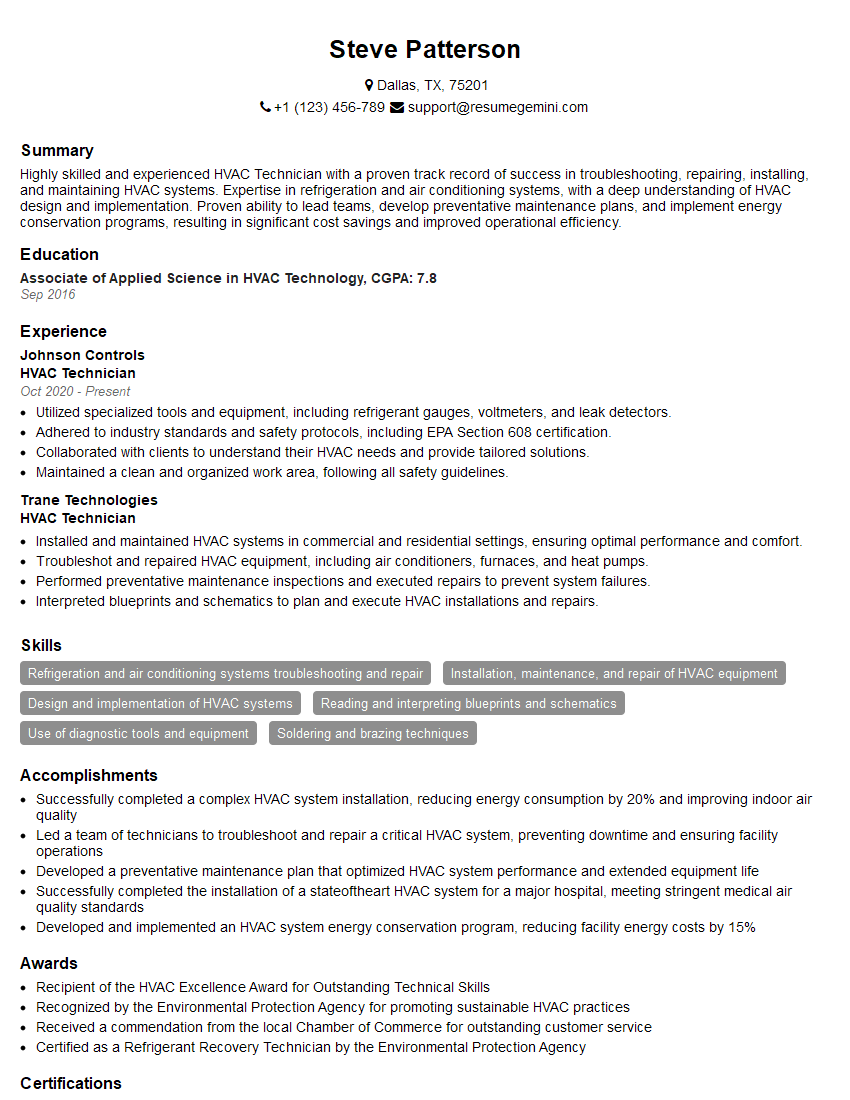Every successful interview starts with knowing what to expect. In this blog, we’ll take you through the top Physical Endurance and Ability to Work in Various Positions interview questions, breaking them down with expert tips to help you deliver impactful answers. Step into your next interview fully prepared and ready to succeed.
Questions Asked in Physical Endurance and Ability to Work in Various Positions Interview
Q 1. Describe your experience managing physical exertion throughout a long workday.
Managing physical exertion throughout a long workday requires a proactive and strategic approach. It’s not just about brute strength, but about pacing, proper posture, and understanding your body’s limits.
My strategy involves several key elements: Pacing – I avoid bursts of intense activity and instead prioritize consistent effort. Think of it like a marathon, not a sprint. Hydration – I consistently drink water throughout the day to prevent dehydration, a major contributor to fatigue. Micro-breaks – taking short, frequent breaks to stretch, walk around, or simply rest my eyes prevents muscle strain and mental fatigue. Proper posture – Maintaining good posture reduces strain on my back and joints. Ergonomic awareness – I’m mindful of my workstation setup and tools to minimize strain. For example, I ensure my chair provides proper lumbar support and I use tools that are appropriately sized and weighted. Finally, listening to my body is crucial. If I experience pain or unusual fatigue, I don’t push through; I address the issue before it becomes a problem.
In a previous role, I was responsible for loading and unloading heavy equipment for eight hours a day. By implementing these strategies, I consistently completed my tasks without experiencing undue fatigue or injury, while maintaining a high level of productivity.
Q 2. How do you prioritize tasks when faced with physically demanding work?
Prioritizing tasks in physically demanding work is about optimizing energy expenditure and efficiency. I use a system that combines urgency, impact, and physical demands. I begin by identifying tasks with tight deadlines (urgency) and those with the greatest impact on overall goals (impact). Then, I assess the physical demands of each task. High-demand tasks are scheduled for times when I have the most energy, often early in the day. Less physically demanding tasks are scheduled for later in the day when fatigue may be setting in. This allows me to tackle the most challenging tasks when I’m freshest.
For instance, if I’m working on a construction site, I would schedule heavy lifting and strenuous activities for the morning when my energy levels are highest, saving less physically demanding tasks like paperwork or organization for the afternoon.
Q 3. Have you ever experienced a physical injury on the job? How did you handle it?
Yes, I once sustained a minor back strain while lifting a heavy object improperly. My immediate response was to stop working and report the injury to my supervisor. I then sought medical attention, following my company’s safety protocols. The injury required physical therapy and a period of modified duty. I learned a valuable lesson about the importance of proper lifting techniques and the need to always prioritize safety. Throughout the recovery process, I maintained open communication with my supervisor and medical professionals to ensure a safe and effective return to work.
Q 4. Explain your approach to maintaining physical fitness for demanding work.
Maintaining physical fitness is paramount for demanding work. My approach is holistic and includes regular exercise, proper nutrition, and sufficient rest. I focus on building strength, endurance, and flexibility. My routine includes cardiovascular exercises like running or swimming to improve endurance, strength training to build muscle and prevent injuries, and stretching to maintain flexibility and range of motion. I also prioritize healthy eating habits, focusing on nutrient-rich foods to fuel my body effectively. Getting adequate sleep is critical for recovery and preventing burnout. Think of it as preventative maintenance for your physical ‘machine’.
Q 5. How do you adapt your work style to different physical demands?
Adapting to different physical demands involves flexibility and a willingness to adjust my approach. I assess the specific demands of the task, considering factors such as lifting, repetitive movements, prolonged standing or sitting, and environmental conditions. I use appropriate tools and equipment to minimize strain and ensure safety. I also adjust my work pace and take more frequent breaks when needed. This might mean using a hand truck for heavy lifting, taking more frequent breaks when performing repetitive movements, or using supportive footwear for prolonged standing. It’s crucial to adapt, not just persevere blindly.
Q 6. Describe a situation where you had to work in uncomfortable or challenging physical conditions.
During a project involving outdoor renovations, I had to work in extremely hot and humid weather conditions for several days. The physical exertion was compounded by the heat, leading to increased fatigue and dehydration risk. To overcome this, I implemented extra hydration breaks, wore appropriate protective clothing that allowed for breathability, and adjusted my work schedule to avoid the hottest part of the day whenever possible. We also had a designated shaded rest area and access to electrolytes to aid hydration and prevent heatstroke. Communication was key – I kept my team and supervisor updated on my well-being and any concerns regarding working conditions.
Q 7. How do you ensure your safety while performing physically strenuous tasks?
Ensuring safety during physically strenuous tasks is my top priority. This includes understanding and adhering to all relevant safety protocols and using appropriate personal protective equipment (PPE). This might range from safety glasses and gloves to harnesses and hard hats, depending on the task. I always lift objects correctly using proper techniques to avoid injuries. I never hesitate to ask for help with heavy or awkward objects, and I always report any unsafe conditions or equipment to my supervisor. Proactive safety measures are always better than reactive treatments. I also frequently assess the work environment, being vigilant of potential hazards and addressing them immediately if possible. A safe work environment is not just the company’s responsibility, but everyone’s.
Q 8. What strategies do you use to prevent physical fatigue and maintain energy levels throughout the day?
Preventing physical fatigue and maintaining energy levels throughout the day requires a holistic approach focusing on proactive measures rather than reactive solutions. It’s akin to maintaining a well-oiled machine – consistent care prevents breakdowns.
Proper Nutrition: Consuming a balanced diet rich in complex carbohydrates, lean proteins, and healthy fats provides sustained energy release, avoiding the blood sugar crashes associated with processed foods. For example, I prioritize breakfasts with oatmeal and berries for slow-burning energy, avoiding sugary cereals.
Hydration: Dehydration significantly impacts energy levels and physical performance. I consistently drink water throughout the day, even before feeling thirsty. A reusable water bottle serves as a visual reminder.
Strategic Breaks: Taking short, regular breaks allows for micro-recovery. Even a 5-10 minute break to stretch, walk around, or simply rest my eyes can significantly improve afternoon energy levels. I often incorporate short mindfulness exercises during these breaks.
Adequate Sleep: Sleep deprivation directly affects physical and cognitive performance. Aiming for 7-8 hours of quality sleep each night is non-negotiable. This includes maintaining a consistent sleep schedule and creating a relaxing bedtime routine.
Physical Activity (Outside of Work): Regular exercise, even moderate activity, strengthens muscles, improves cardiovascular health, and boosts overall energy levels. However, it’s crucial to balance this with adequate rest and recovery.
Q 9. How would you handle a situation where you’re required to work overtime with heavy physical demands?
Handling overtime with heavy physical demands requires careful planning and prioritization of safety. It’s not just about pushing through; it’s about sustainable productivity. My approach is based on three pillars: communication, pacing, and recovery.
Communication: I would openly communicate with my supervisor about my physical capacity and any potential limitations. This ensures realistic expectations and prevents unsafe situations.
Pacing: I would prioritize tasks and break down large jobs into smaller, manageable segments. This prevents exhaustion and reduces the risk of injury. Frequent short breaks are crucial.
Recovery: Proper nutrition, hydration, and rest are paramount. This might involve consuming energy bars or electrolyte drinks during breaks. Post-overtime, I would prioritize rest and recovery to avoid burnout.
Q 10. What is your experience with lifting heavy objects or using specialized equipment?
My experience with lifting heavy objects and using specialized equipment is extensive and includes comprehensive training in proper lifting techniques to minimize risk of injury. I have experience operating forklifts (with certification), pallet jacks, and other material handling equipment, always adhering to safety protocols.
In terms of heavy lifting, I’ve regularly lifted loads exceeding 50 pounds (23 kg), always using proper body mechanics, including bending at the knees, keeping the back straight, and lifting with my legs, not my back. I am comfortable with various lifting aids, such as hoists and dollies, when necessary.
Q 11. How do you stay focused and productive during physically demanding shifts?
Maintaining focus and productivity during physically demanding shifts relies on both physical and mental strategies. It’s about optimizing performance through mindfulness and physical conditioning.
Mindfulness and Breaks: Regular short breaks are crucial. These breaks help clear my mind, reduce stress and allow for brief physical recovery. Practicing mindfulness techniques during breaks helps center my focus.
Prioritization: I break down tasks into smaller, more manageable units. This allows for a sense of accomplishment, which is motivating and keeps me focused on completing the next step.
Physical Conditioning: Good physical health is fundamental. This means consistent exercise to build endurance and strength. This allows me to handle physical demands more effectively with less fatigue.
Hydration and Nutrition: Maintaining proper hydration and consuming nutritious snacks throughout the shift helps maintain energy levels and cognitive function. Avoiding sugary drinks and opting for healthier options is essential.
Q 12. Describe a time you had to work in multiple physically demanding positions within one day.
During my previous role at a warehouse, I routinely worked in multiple physically demanding positions in a single day. This involved tasks like unloading trucks (heavy lifting and carrying), operating a forklift (extensive use of arms and legs), and sorting and stacking inventory (repetitive bending and lifting).
To manage this, I strategically sequenced my tasks, prioritizing heavier lifting early in the day when my energy levels were highest. I also integrated short breaks between different activities to allow for physical recovery and a change of pace. This prevented muscle strain and maximized my overall efficiency throughout the day.
Q 13. How do you manage stress related to physically demanding work?
Managing stress related to physically demanding work requires a multifaceted approach that combines proactive strategies with effective coping mechanisms.
Physical Activity (Outside of Work): Regular exercise acts as a powerful stress reliever. Activities like yoga or running help release endorphins, improving mood and reducing stress hormones.
Mindfulness and Relaxation Techniques: Deep breathing exercises, meditation, and even listening to calming music can significantly reduce stress levels. Practicing these techniques regularly equips me with tools to handle stressful situations effectively.
Social Support: Connecting with friends, family, or colleagues allows for emotional release and provides a supportive network to help cope with work-related stress. Talking about challenges can often ease the burden.
Prioritize Sleep and Nutrition: Maintaining a healthy sleep schedule and a balanced diet is crucial for managing stress. These habits provide the physical and mental resilience to handle physically demanding work.
Q 14. What is your understanding of workplace safety regulations regarding physical exertion?
My understanding of workplace safety regulations regarding physical exertion is comprehensive and involves awareness of both general safety regulations and those specific to manual handling and lifting. This includes adhering to guidelines set by OSHA (Occupational Safety and Health Administration) or equivalent regulatory bodies in other countries.
Manual Handling Regulations: This includes proper lifting techniques, the use of mechanical aids, and understanding weight limits for manual lifting.
Risk Assessments: Familiar with the process of conducting and participating in workplace risk assessments, which identify and mitigate hazards related to physical exertion, such as repetitive strain injuries or musculoskeletal disorders.
Reporting Procedures: I understand the importance of reporting any incidents or near misses, ensuring that potential hazards are addressed promptly to prevent injuries.
Personal Protective Equipment (PPE): Proficient in the proper use of PPE, such as safety shoes, gloves, or back supports, as appropriate for the task to reduce the risk of injury.
Q 15. Explain your experience with repetitive motions or prolonged standing/sitting.
My experience with repetitive motions and prolonged standing or sitting is extensive. I’ve worked in roles requiring repetitive tasks like assembly line work, where I performed the same motion hundreds of times a day. This necessitates a focus on proper posture and ergonomic techniques to prevent injuries. Similarly, I’ve spent considerable time in roles demanding prolonged standing, such as warehouse work, and prolonged sitting, like data entry. In both scenarios, I developed strategies to mitigate fatigue and discomfort. For example, during prolonged standing, I’d utilize anti-fatigue mats and take short, frequent breaks to stretch and change position. During prolonged sitting, I made sure to maintain correct posture, take regular breaks to walk around, and use an ergonomic chair with proper lumbar support.
Understanding the impact of these motions is crucial; I actively work to prevent musculoskeletal disorders (MSDs). This includes utilizing recommended stretches and exercises, reporting any discomfort immediately, and advocating for ergonomic adjustments to my workspace. My experience has taught me the importance of proactive prevention rather than reactive treatment of work-related injuries.
Career Expert Tips:
- Ace those interviews! Prepare effectively by reviewing the Top 50 Most Common Interview Questions on ResumeGemini.
- Navigate your job search with confidence! Explore a wide range of Career Tips on ResumeGemini. Learn about common challenges and recommendations to overcome them.
- Craft the perfect resume! Master the Art of Resume Writing with ResumeGemini’s guide. Showcase your unique qualifications and achievements effectively.
- Don’t miss out on holiday savings! Build your dream resume with ResumeGemini’s ATS optimized templates.
Q 16. Describe your experience with working in extreme weather conditions.
I have extensive experience working in extreme weather conditions. During my time as a field technician, I worked outdoors regardless of the weather – blazing summer heat, freezing winter temperatures, heavy rain, and strong winds. I’ve learned to adapt my work habits and protective gear to cope. This includes using appropriate clothing: layers in cold weather, breathable fabrics in heat, waterproof gear in rain. I also incorporate regular breaks in shaded areas during hot weather and extra layers in the cold. Hydration and sun protection are paramount; I always carry plenty of water and wear sunscreen and a hat in sunny conditions.
Beyond physical preparation, effective communication is key. In extreme weather, safety is always a priority. I’ve consistently communicated any concerns about unsafe working conditions to my supervisors, emphasizing the need for adjustments to the work schedule or protective measures.
Q 17. How do you communicate your physical limitations or needs to your supervisor?
Communicating physical limitations is a crucial part of maintaining safety and productivity. My approach is proactive and direct. I prefer to inform my supervisor in a timely manner, ideally *before* a problem arises. For example, if I anticipate a task might exacerbate a pre-existing back condition, I’ll explain the potential issue and suggest alternative approaches or the need for assistance. I present these concerns in a constructive manner, focusing on solutions rather than complaints. I offer specific examples and suggest realistic accommodations, such as adjusted work schedules, modified tasks, or the use of assistive devices.
Clear and concise communication is crucial. I use clear language, avoid jargon, and focus on the impact of my limitations on my ability to perform tasks safely and efficiently. Documentation is also important; I maintain records of any communicated limitations and accommodations made, including dates and specific details. This ensures a clear trail for both myself and my supervisor.
Q 18. What are your preferred methods for staying hydrated and energized during physical work?
Staying hydrated and energized is crucial for maintaining performance during physically demanding work. My preferred methods center around proactive planning and mindful choices. For hydration, I carry a large water bottle and aim to sip water consistently throughout the workday, rather than waiting until I’m thirsty. I also avoid sugary drinks which can lead to a later energy crash. For energy, I focus on consuming nutrient-rich foods. This often means packing snacks like fruits, vegetables, and whole-grain crackers. I avoid heavy meals before or during physical work as these can cause discomfort and sluggishness.
Electrolyte drinks are also very useful for replenishing minerals lost through sweat, particularly during prolonged physical exertion in hot weather. I choose options low in sugar to avoid the energy spikes and dips.
Q 19. How do you recover from physically demanding workdays?
Recovery after physically demanding workdays is essential for preventing injuries and maintaining long-term health. My recovery strategy consists of several key components. Firstly, adequate rest and sleep is paramount. Aiming for 7-8 hours of quality sleep allows the body to repair and rebuild muscle tissues. Secondly, I prioritize proper nutrition, focusing on protein-rich foods to support muscle recovery, and sufficient hydration. Regular stretching and light exercises, such as walking, helps improve blood circulation and reduce muscle soreness. I avoid strenuous activities that could further strain my muscles on recovery days.
Finally, listening to my body is critical. If I experience persistent pain or discomfort, I consult with a healthcare professional. Early intervention is key to preventing minor issues from escalating into major problems. Rest and recovery are not luxuries, they are essential components of maintaining physical well-being and sustaining peak performance.
Q 20. Describe your experience working with a team in a physically demanding environment.
Working in a team in a physically demanding environment requires excellent communication and teamwork. My experience includes construction projects and warehouse operations where collaborative effort is vital. Effective teamwork involves clear communication of roles and responsibilities, ensuring everyone understands their part in the overall task. Mutual support and respect are paramount. For instance, if one team member is struggling with a heavy load, others assist to prevent injuries and maintain productivity. Effective communication also includes promptly reporting any safety concerns or potential hazards to the team and supervisor.
Teamwork can be enhanced by establishing clear expectations, such as designated break times and methods of communication for safety concerns. Regular team meetings for feedback and coordination contribute to the creation of a supportive and efficient environment.
Q 21. Have you worked in a fast-paced environment with high physical demands?
Yes, I have worked in numerous fast-paced environments with high physical demands. My experience in food processing and logistics involved handling large quantities of materials under strict time constraints. Maintaining efficiency requires organizational skills, prioritization, and maintaining stamina. Strategies I found particularly effective include maintaining a consistent pace, and optimizing workflows to avoid unnecessary movements or delays. Proper communication with supervisors and team members is also crucial for adapting to changes in demand or unexpected issues. Staying hydrated and energized helps to maintain a high level of performance. In high-pressure scenarios, breaks are still vital for preventing injury and burnout.
One key takeaway is that in fast-paced environments, proactive risk assessment and prevention are essential. Identifying potential hazards and taking preventative measures goes a long way in maintaining both efficiency and safety.
Q 22. How do you prioritize safety over speed in physically demanding tasks?
Prioritizing safety over speed in physically demanding tasks is paramount. It’s not a trade-off, but a fundamental principle. Speed without safety leads to injuries, inefficiency, and potential long-term health problems. My approach involves a multi-step process:
- Proper planning and assessment: Before starting any task, I carefully evaluate the potential hazards, considering factors like weight, distance, terrain, and necessary tools. This allows for planning a safe and efficient approach.
- Utilizing correct techniques: I always employ proper lifting techniques, ensuring correct posture, minimizing strain, and maximizing leverage. For example, using my legs instead of my back when lifting heavy objects. I also understand and utilize appropriate equipment to support the job, like harnesses or lifting aids.
- Taking regular breaks: Fatigue dramatically increases the risk of injury. I schedule regular breaks to rest and rehydrate, allowing my body to recover and remain alert. These breaks are not about slowing down the overall process, but about ensuring I can work safely and efficiently for longer periods.
- Knowing my limits: It’s crucial to be self-aware. If a task is beyond my physical capabilities or if I feel unsafe, I immediately stop and seek assistance. This is not a sign of weakness but a demonstration of responsible work practices.
- Communicating clearly: Open communication with colleagues and supervisors is critical. I will promptly report any unsafe conditions or concerns to ensure that the right steps are taken to mitigate risk.
Think of it like a marathon, not a sprint. A consistent, safe pace ensures you reach the finish line without injury, while rushing increases the risk of tripping and falling, ultimately slowing you down significantly.
Q 23. Describe a time you had to make adjustments due to a change in physical workload.
During a warehouse inventory, we experienced an unexpected surge in incoming shipments. This drastically increased the physical workload; we were handling three times the usual volume of boxes. My initial response was to maintain my established safe working practices; however, the increased volume meant I was at risk of overexertion.
I made the following adjustments:
- Increased break frequency and duration: I took more frequent and longer breaks to prevent fatigue.
- Prioritized tasks strategically: I focused on the most urgent tasks first and delegated less critical work if feasible, to ensure efficient workload management.
- Communicated needs: I informed my supervisor about the increased workload and the need for additional personnel or equipment if the situation continued. This helped to prevent burnout and potential injuries.
- Modified lifting technique: Instead of carrying multiple boxes simultaneously, I opted for smaller, more frequent trips using a hand truck to minimize strain.
These adjustments ensured I could maintain a high level of productivity while mitigating the risk of injury. The key was proactive communication and adaptability.
Q 24. How do you handle unexpected physical challenges during your work?
Unexpected physical challenges, such as a sudden equipment malfunction or a change in the environment, require immediate assessment and response. My approach focuses on problem-solving and risk mitigation:
- Assess the situation: First, I thoroughly assess the nature of the challenge and any potential risks it poses.
- Implement immediate safety measures: This may involve temporarily stopping work, securing the affected area, or using alternative methods.
- Seek assistance if needed: If the challenge is beyond my capabilities, I immediately seek help from supervisors or colleagues.
- Document the incident: After addressing the challenge, I document what happened, the steps taken, and any resulting injuries or damage. This information is valuable for future prevention.
- Adapt my approach: If the challenge is ongoing or likely to recur, I adapt my work techniques to account for the change, ensuring continued safety and efficiency.
For example, if a heavy piece of equipment malfunctions, I would immediately switch it off, warn colleagues, and contact maintenance before attempting any repairs. My focus remains consistently on safety first, adapting as needed.
Q 25. What are your strategies for managing pain or discomfort during physically demanding work?
Managing pain or discomfort during physically demanding work is crucial for both short-term productivity and long-term health. My strategies involve a combination of preventative measures and responsive actions:
- Preventative measures: Regular exercise, stretching before and after work, maintaining proper hydration, and ensuring adequate sleep are all essential in minimizing risk of pain and injury.
- Pain management techniques: If pain arises, I use techniques like stretching, applying heat or ice packs, and using over-the-counter pain relievers (as directed).
- Adjusting work techniques: If specific movements cause pain, I modify my technique or take breaks to alleviate strain. This might involve changing my grip, posture, or using different tools.
- Seeking professional help: If pain persists or worsens despite these measures, I immediately seek medical attention. Ignoring pain can lead to more serious problems.
- Proper posture: Maintaining good posture reduces muscle strain and back pain. Think about standing tall with your shoulders relaxed and back straight.
Treating pain as a warning signal, rather than something to ignore, is key to maintaining both physical well-being and work performance.
Q 26. How familiar are you with ergonomic principles and their application in the workplace?
Ergonomic principles are central to safe and efficient work practices. I’m highly familiar with their application, understanding that proper workstation setup, tool design, and movement patterns significantly impact physical health and productivity. My knowledge includes:
- Workstation setup: Proper chair height, monitor placement, keyboard and mouse positioning to minimize strain and promote good posture. This means ensuring my elbows are at a 90-degree angle, my wrists are straight and my back is supported.
- Tool selection and use: Using tools designed for the task at hand, and employing correct techniques to minimize strain, such as using power tools when appropriate.
- Lifting techniques: Understanding and applying safe lifting techniques to prevent back injuries; always bending at the knees, keeping the load close to the body, and using leg muscles, not back muscles, for lifting.
- Body mechanics: Awareness of how the body moves and interacts with the work environment to minimize stress on joints, muscles, and tendons. I understand how to optimize movements to avoid awkward postures and repetitive strain.
- Work-rest cycles: Implementing regular breaks to avoid fatigue and muscle strain. Frequent short breaks are more effective than one long break.
I routinely apply these principles to my work to ensure a safe and comfortable working environment. Ignoring ergonomics often results in increased pain, fatigue, and a reduced ability to perform tasks effectively.
Q 27. Have you ever needed to modify your technique to reduce physical strain?
Yes, I’ve often had to modify my techniques to reduce physical strain. During a prolonged project involving repetitive overhead work, I initially experienced significant shoulder pain. I realized my technique was causing undue strain.
I made the following adjustments:
- Changed my grip: I shifted from a tight, strained grip to a more relaxed and comfortable one.
- Adjusted my posture: I incorporated short breaks to reposition myself, ensuring better alignment and distributing the load more evenly across my muscles.
- Introduced micro-breaks: I frequently stopped, stretched my shoulders, and rotated my arms to relieve tension, which significantly reduced the pain.
- Used assistive tools: I found a scaffolding system that allowed me to perform the overhead work at a more comfortable height, reducing physical exertion.
This adaptive approach not only prevented further injury but also increased my overall efficiency. Flexibility and a willingness to adjust based on feedback from my body are essential.
Q 28. Describe a time you successfully overcome a physically demanding challenge.
During a long-distance hiking trip with heavy gear, I faced a particularly challenging ascent involving steep terrain and slippery rocks. Initially, I struggled to maintain a consistent pace, leading to fatigue and near misses. I adapted my strategy in the following way:
- Pace adjustment: I slowed down significantly, prioritizing safety over speed. Short, frequent breaks allowed for recovery and strategic planning.
- Technique modification: I carefully assessed the terrain, choosing the most stable routes and using trekking poles for better balance and support.
- Hydration and nutrition: I maintained regular hydration and consumed energy bars for sustained energy levels.
- Mental fortitude: I kept a positive and patient mindset, breaking the climb down into smaller, more manageable sections.
By carefully adjusting my approach, I successfully completed the challenging climb without injury. This experience highlighted the importance of adaptation, perseverance, and careful planning in overcoming physically demanding challenges.
Key Topics to Learn for Physical Endurance and Ability to Work in Various Positions Interview
- Understanding Physical Endurance: Explore the physiological factors contributing to endurance, including cardiovascular fitness, muscular strength and endurance, and flexibility. Consider how different work environments demand varying levels of each.
- Adaptability to Diverse Physical Demands: Discuss your experience adapting to different physical tasks, such as lifting, carrying, bending, twisting, and prolonged standing or sitting. Provide examples showcasing your ability to adjust to changing physical requirements.
- Safety and Ergonomics: Demonstrate understanding of proper lifting techniques, workplace safety procedures, and ergonomic principles to prevent injuries and maintain efficiency in various work positions.
- Maintaining Physical Fitness: Highlight your commitment to maintaining physical fitness relevant to the job. Discuss strategies for preventing fatigue and maintaining optimal performance throughout the workday.
- Stamina and Recovery: Explain your understanding of the body’s recovery process after strenuous physical activity and how you manage your energy levels to maintain consistent performance.
- Problem-Solving in Physically Demanding Situations: Discuss scenarios where you had to overcome physical challenges or adapt to unexpected physical demands in a professional setting. Focus on your problem-solving skills and ability to find efficient and safe solutions.
- Communication and Teamwork in Physical Tasks: Explain your approach to communication and teamwork when completing physically demanding tasks, emphasizing safety and efficiency.
Next Steps
Mastering physical endurance and adaptability to various positions is crucial for career advancement in many fields. It demonstrates your commitment to job safety, efficiency, and overall professional excellence. To significantly enhance your job prospects, creating a strong, ATS-friendly resume is essential. ResumeGemini is a trusted resource that can help you build a professional resume that highlights your capabilities effectively. Examples of resumes tailored to showcasing physical endurance and adaptability are available to help you craft your compelling application materials.
Explore more articles
Users Rating of Our Blogs
Share Your Experience
We value your feedback! Please rate our content and share your thoughts (optional).

